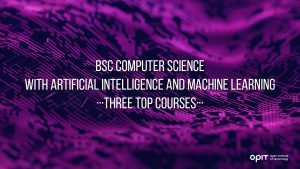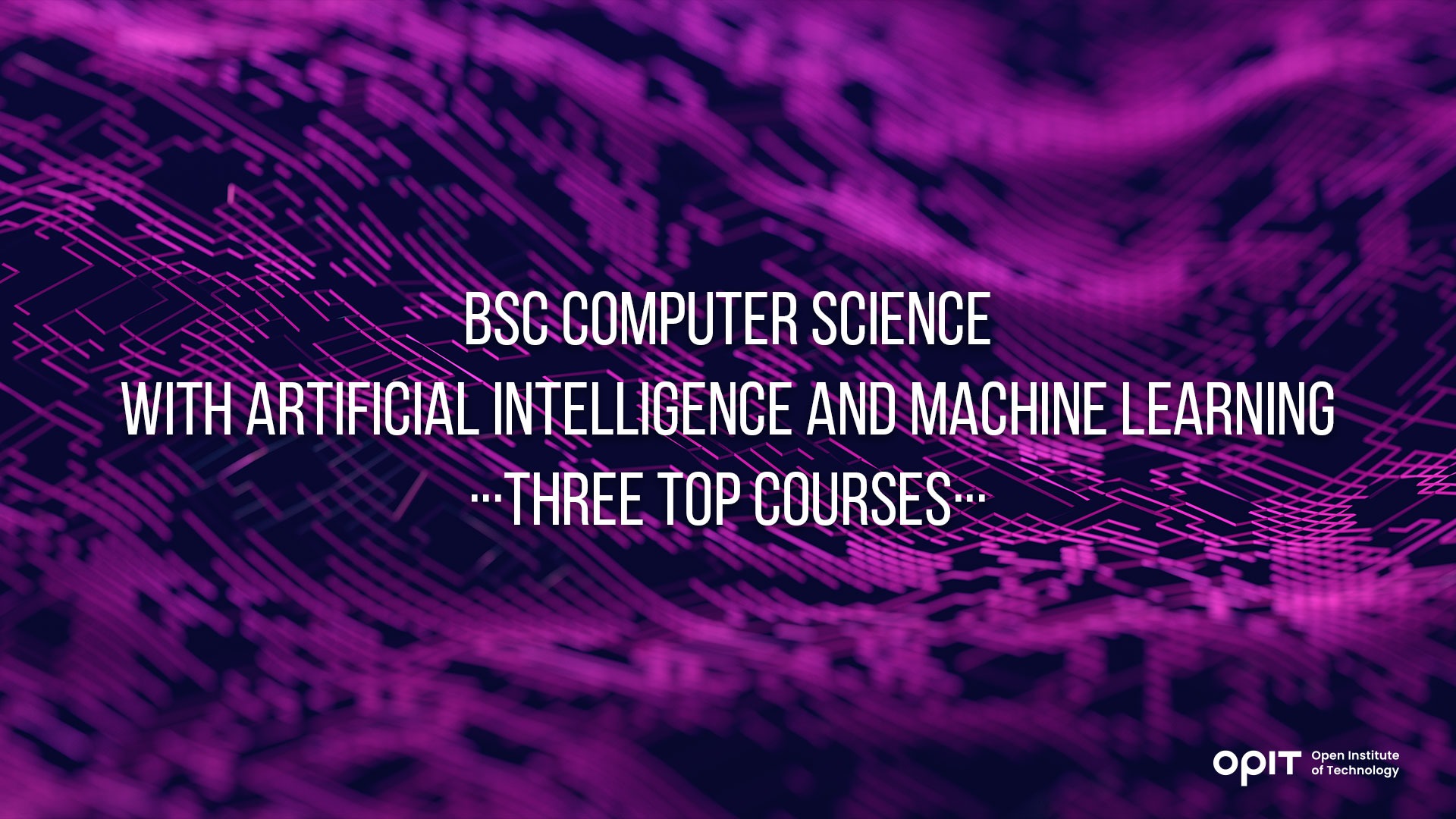AI is already a massive industry – valued at $136.55 billion (approx. €124.82 billion) as of 2022 – and it’s only going to get bigger as we come to grips with what AI can do. As a student, you stand on the cusp of the AI tidal wave and you have an opportunity to ride that wave into a decades-long career.
But you need a starting point for that career – a BSc computer science with artificial intelligence. The three courses discussed in this article are the best for budding AI masters.
Factors to Consider When Choosing a BSc Computer Science With AI Program
Before choosing your BSc, you need to know what to look for in a good course:
- Institution Accreditation – Whoever provides the course should offer solid accreditation so that you know you can trust the institution and that potential future employers actually respect the qualification you have on your VC.
- An AI-Focused Curriculum – Not all computer science bachelor’s degrees are the same. The one you choose needs to offer a specific focus on AI or machine learning so you can build the foundations for later specialization.
- Faculty Expertise – A course led by instructors who don’t know much about AI is like the blind leading the blind. Every mentor, instructor, and lecturer needs to have provable knowledge and industry experience.
- Job Opportunities – Every chance you have to “get your hands dirty” with AI is going to look great on your CV. Look for courses that create pathways into internships and job programs. Associations with organizations like IBM are a great place to start.
- Financial Aid – It isn’t cheap to study a BSc artificial intelligence and machine learning. Degrees cost thousands of Euros per year (the average in Europe is about €3,000, though prices can go higher) so the availability of financial aid is a huge help.
Top BSc Computer Science With AI Programs
Studying from the best is how you become a leader in the AI field. The combination of expert tuition and the name recognition that comes from having a degree from one of the following institutions stands you in good stead for success in the AI industry. Here are the top three organizations (with degrees available to overseas students) in the world.
Check out OPIT degrees
-
Career aligned
-
Fully Online
-
EU-accredited institution
Course 1 – BSc Artificial Intelligence – The University of Edinburgh
Named as one of the top 10 AI courses in the world by Forbes, The University of Edinburgh’s offering has everything you need from a great BSc computer science with artificial intelligence. It’s a four-year full-time course that focuses on the applications of AI in the modern world, with students developing the skills to build intelligent systems capable of making human-like decisions. The course is taught by the university’s School of Informatics, led by National Robotarium academic co-lead Professor Helen Hastie.
The course starts simple, with the first year dedicated to learning the language of computers before the second year introduces students to software development and data science concepts. By the third year, you’ll be digging deep into machine learning and robotics. That year also comes with opportunities to study abroad.
As for career prospects, The University of Edinburgh has a Careers Service department that can put you in line for internships at multi-national businesses. Add to that the university’s huge alumni network (essentially a huge group of professionals willing to help students with their careers) and this is a course that offers a great route into the industry.
Course 2 – Artificial Intelligence Program – Carnegie Mellon University
Ranked as the top university in the world for AI courses by Edurank, Carnegie Mellon University is a tough nut to crack if you want to study its world-renowned program. You’ll face a ton of competition, as evidenced by the university’s 17% acceptance rate, and the program is directed by Reid Simmons. For those who don’t recognize the name, he’s been a frontrunner in leveraging AI for NASA and was the creator of the “Robotceptionist.”
As for the course, it blends foundational mathematical, statistical, and computer science concepts with a wide variety of AI modules. It’s robotics-focused (that’s no surprise given the director), though you’ll also learn how AI applies on a perceptive level. The use of AI in speech processing, search engines, and even photography are just some examples of the concepts this course teaches.
Carnegie Mellon takes an interesting approach to internships, as it offers both career and academic internships. Career internships are what you’d expect – placements with major companies where you get to put your skills into practice. An academic internship is different because you’ll be based in the university and will work alongside its faculty on research projects.
Course 3 – BSc in Artificial Intelligence and Decision Making – Massachusetts Institute of Technology (MIT)
It should come as no surprise that MIT makes it onto the list given the school’s engineering and tech focus. Like Carnegie Mellon’s AI course, it’s tough to get into the MIT course (only a 7% acceptance rate) but simply having MIT on your CV makes you attractive to employers.
The course takes in multiple foundational topics, such as programming in Python and introductions to machine learning algorithms, before moving into a robotics focus in its application modules. But it’s the opportunities for research that make this one stand out. MIT has departments dedicated to the use of AI in society, healthcare, communications, and speech processing, making this course ideal for those who wish to pursue a specialization.
Networking opportunities abound, too. MIT’s AI faculty has 92 members, all with different types of expertise, who can guide you on your path and potentially introduce you to career opportunities. Combine that with the fact you’ll be working with some of the world’s best and brightest and you have a course that’s built for your success in the AI industry.
Emerging BSc Computer Science With AI programs
Given that AI is clearly going to be enormously important to developing industry in the coming years, it’s no surprise that many institutions are creating their own BSc computer science with artificial intelligence courses. In the UK alone, the likes of Queen’s University Belfast and Cardiff University are quickly catching up to The University of Edinburgh, especially in the robotics field.
In North America, the University of Toronto is making waves with a course that’s ranked the best in Canada and fifth in North America by EduRank. Interestingly, that course is a little easier to get into than many comparable North American courses, given its 43% acceptance rate.
Back in the UK, the University of Oxford is also doing well with AI, though its current courses tend to be shorter and specialized in areas like utilizing AI in business. We’re also seeing Asian universities make great progress with their courses, as both Tsinghua University and Nanyang Technological University are establishing themselves as leaders in the space.
Importance of Hands-On Experience and Internships
As important as foundational and theoretical knowledge is, it’s when you get hands-on that you start to understand how much of an impact AI will have on business and society at large. Good universities recognize this and offer hands-on experience (either via research or internship programs) that offer three core benefits:
- Gain Practical Skills – Becoming a walking encyclopedia for the theory of AI is great if you intend on becoming a teacher. But for everybody else, working with hands-on practical experiments and examples is required to develop the practical skills that employers seek.
- Networking – A strong faculty (ideally with industry as well as academic connections) will take you a long way in your BSc computer science with artificial intelligence. The more people you encounter, the more connections you build and the better your prospects are when you complete your course.
- Enhanced Job Prospects – Getting hands-on with real-world examples, and having evidence of that work, shows employers that you know how to use the knowledge you have knocking around your head. The more practical a course gets, the better it enhances your job prospects.
Scholarships and Financial Aid Opportunities
Due to BSc artificial intelligence and machine learning courses being so expensive (remember – an average of €3,000 per year), financial aid is going to be important for many students. In the UK, that aid often comes in the form of student loans, which you don’t have to start repaying until you hit a certain earnings threshold.
When we take things Europe-wide, more scholarship and financial aid programs become available. The Erasmus program offers funding for master’s students (assuming they meet the criteria) and there are several scholarship portals, such as EURAXESS and Scholarshipportal designed to help with financial aid.
If this is something you’re interested in, the following tips may help you obtain funding:
- Excel academically in pre-university studies to demonstrate your potential
- Speak to the finance teams at your university of choice to see what’s currently available
- Apply for as many scholarship and aid programs as you can to boost your chances of success
Try the Top BSc Artificial Intelligence and Machine Learning Programs
The three BSc computer science with artificial intelligence programs discussed in this article are among the best in the world for many reasons. They combine intelligence course focuses with faculty who not only know how to teach AI but have practical experience that helps you learn and can serve useful networking purposes.
The latter will prove increasingly important as the AI industry grows and becomes more competitive. But as with any form of education, your own needs are paramount. Choose the best course for your needs (whether it’s one from this list or an online BSc) and focus your efforts on becoming the best you can be.
Check out OPIT degrees
-
Career aligned
-
Fully Online
-
EU-accredited institution






